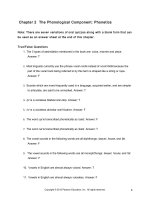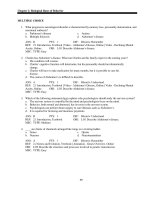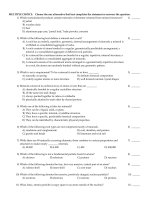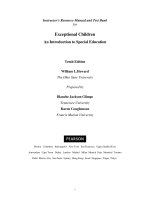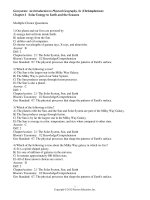Introduction to forensic psychology 3rd edition bartol test bank
Bạn đang xem bản rút gọn của tài liệu. Xem và tải ngay bản đầy đủ của tài liệu tại đây (258.13 KB, 10 trang )
Bartol, Introduction to Forensic Psychology: Research and Application, 3e
Instructor Resource
CHAPTER 2
POLICE PSYCHOLOGY
TEST BANK
Multiple Choice
1. According to the text, police psychology officially began in _____ with the hiring of _____.
a) 1968; Martin Reiser
b) 1976; Kim Rossmo
c) 1968; Stephen Chandler
d) 1967; Patrick Allen
e) 1987; Ellen Kirschman
2. An understanding of _____ is a crucial element of effective police psychology.
a) police culture
b) the cycle of violence
c) victim’s rights
d) the attorney-client privilege
e) the DSM-V
3. According to professor Robert Woody, a frequent source of stress for police officers and one
not often noted in research literature is:
a) low pay and poor benefits.
b) constant performance evaluations by supervisors.
c) limited opportunity to socialize with colleagues.
d) stalking by disgruntled citizens.
e) harassment by citizens.
4. A psychologist who participates in the selection and training of hostage negotiation teams is
conducting which type of evaluation?
a) Fitness-for-duty
b) SWAT
c) CISD
d) Special unit
e) Deadly force assessment
5. Which one of the following is NOT one of Aumiller and Corey’s (2007) domains of
practice?
a) Assessment
b) Intervention
c) Operational support
d) Organizational consultation
e) Augmentation
6. CISD stands for:
Bartol, Introduction to Forensic Psychology: Research and Application, 3e
a)
b)
c)
d)
e)
Instructor Resource
Correctional Institution Standardized Development
Criminal Inmate Stress Disorder
Canadian Institute for Stress Disorders
Correctional Implementation for Safety Dormitories
Critical Incidents Stress Debriefing
7. _____ refers to the systematic procedure for identifying the skills, abilities, knowledge, and
psychological characteristics that are needed to do public safety work successfully.
a) Law enforcement screening
b) Job analysis
c) Pre-employment screening
d) Comprehensive skills analysis
e) Employment evaluation
8. Which of the following traits has NOT been shown to be related to successful police
performance?
a) Trustworthiness
b) Good judgment
c) Solid memory
d) High intelligence
e) Oral and written communication skills
9. In regard to screening employment applicants, the Equal Employment Opportunity
Commission divided disability inquiries into two stages. These stages are:
a) pre-offer of employment and post offer/prehire.
b) medical and psychological.
c) performance-related and health-related.
d) negligent and non-negligent.
e) accommodating and holding.
10. The screening procedure that assumes that there are traits, habits, reactions and attitudes that
distinguish outstanding from satisfactory police performance is called:
a) screening-in.
b) screening-out.
c) reasonable accommodation.
d) natural selection.
e) promotional selection.
11. Which of the following is NOT a personality instrument currently used in law enforcement
screening?
a) IPI
b) CPI
c) MMPI-2
d) NEO PI-R
e) STATIC-99
Bartol, Introduction to Forensic Psychology: Research and Application, 3e
Instructor Resource
12. According to the text, the most commonly used psychological instrument in public safety
screening is the:
a) IPI.
b) CPI.
c) MMPI-2.
d) NEO PI-R.
e) STATIC-99.
13. The inventory containing true or false questions designed to measure how adolescents and
adults with behave in a variety of interpersonal situations is called the:
a) IPI.
b) CPI.
c) MMPI-2.
d) NEO-PI-R.
e) STATIC-99.
14. A law enforcement fitness-for-duty evaluation (FFDE) report is owned by the:
a) Federal Bureau of Prisons.
b) officer.
c) agency who requested the report.
d) police chief.
e) psychologist.
15. According to Stone (1995), _____ accounts for 19% of law enforcement FFDE referrals.
a) on the job substance abuse
b) excessive use of force
c) suicidal ideation
d) signs and symptoms of mental instability
e) suspected fraternization
16. The degree to which a test measures what it’s supposed to measure is called _____ validity.
a) predictive
b) content
c) construct
d) proactive
e) substantial
17. Low pay and shift work are examples of _____ occupational stressors.
a) constructive
b) personal
c) external
d) organizational
e) personal
18. Officer Ludden is a 36-year-old father of twin girls who is called to the scene of an auto
accident in which a drunk driver has killed a 4-year-old girl. Despite his anger and sadness,
Bartol, Introduction to Forensic Psychology: Research and Application, 3e
Instructor Resource
Officer Ludden stoically informs the child’s father that his daughter has died. The officer is
likely experiencing:
a) emotional dissonance.
b) subterfuge.
c) cognitive dissonance.
d) PSTR.
e) expressionless displacement.
19. Boredom and exposure to violence are examples of _____ stressors.
a) occupational
b) constructive
c) external
d) personal
e) task-related
20. A critical incident is characterized by a _____ and _____ event.
a) non-routine; unanticipated
b) violent; sudden
c) traumatic; violent
d) stressful; extraordinary
e) criminal; exclusionary
21. Following the traumatic event, it is important that a critical incident intervention be:
a) extensive.
b) immediate.
c) excessive.
d) immaculate.
e) extraordinary.
22. Research has shown that when considering mental health services, many police officers
prefer to work with:
a) competent mental health professionals who are not officers.
b) officers who have received training in critical incidents stress debriefing.
c) peer counselors who understand the cycle of violence.
d) same gender professionals.
e) mental health professionals who have at least ten years of clinical experience.
23. According to research by Solomon and Horn (1986), _____ was the most common reaction
experienced by officers AFTER a shooting incident.
a) lethargy
b) sleep difficulties
c) suicidal ideation
d) unexplained elation
e) marital troubles
Bartol, Introduction to Forensic Psychology: Research and Application, 3e
Instructor Resource
24. Aamodt and Stalnaker (2001) found that the overwhelming reason for most police suicides
appears to be:
a) financial difficulties.
b) critical incidents.
c) easy access to weapons.
d) internal investigations.
e) intimate partner relationships.
25. Nearly 80% of all hostage situations:
a) are relationship-driven.
b) end in death of the hostage taker.
c) end in death of the hostage negotiator.
d) are politically motivated.
e) involve terrorism.
26. Which category of hostage taker often requires the involvement of federal officials and is
considered the most difficult for police officers?
a) Political
b) Prisoners
c) Criminals
d) Mental disorder
e) Trapped
27. Early warning systems are used to identify:
a) female officers at risk for sexual harassment.
b) potential problem behaviors in officers.
c) suspects who are vulnerable to coercion.
d) individuals who may not understand Miranda Rights.
e) officers who are insensitive to diversity issues.
28. A psychologist who assists in witness interviews and assists in the decision making strategy
of the entire team is participating in which role of hostage situations?
a) Primary negotiator
b) Intelligence officer
c) Consultant/adviser
d) Primary controller
e) Integrated team member
29. The primary aim of terrorism is to:
a) physically debilitate the largest number of human beings.
b) promote violence.
c) accomplish a political goal.
d) cause harm to a specific group of individuals.
e) generate fear.
Bartol, Introduction to Forensic Psychology: Research and Application, 3e
Instructor Resource
30. _____ is a phenomenon that occurs when an innocent person comes to believe that he or she
actually committed a crime.
a) Coerced-internalized false confession
b) Coerced-compliant false confession
c) Voluntary false confession
d) Self-incriminating confession
e) Generalized false confession
31. In 1932, 200 people came forward and confessed to kidnapping the first-born child of
Charles and Anne Lindbergh. This is an example of a _____ confession.
a) coerced-internalized false
b) group-think
c) voluntary false
d) self-incriminating
e) coerced-compliant false
32. Which of the following statements MOST ACCURATELY describes the current state of
women and minorities in policing?
a) Women and minorities outnumber men in rural police departments only.
b) Women and minorities outnumber men in urban police departments only.
c) Research has shown that both women and minorities have a hard time keeping up with
the physical demands of policing in both rural and urban departments.
d) The vast majority of large police departments have no women of color in top command
positions.
e) Both women and minorities seem to have negative attitudes about policing.
33. In a 1996 study of women NYPD officers, Morris found that:
a) the majority of women had been sexually harassed on the job.
b) women were less likely than men to socialize with other officers off the clock.
c) women tended to have a large network of friends within the police community.
d) women were more likely than men to have experienced some form of victimization.
e) most of the women were not in an intimate partner relationship.
34. Which of the following was a key finding of the National Institute of Justice’s 1999 report on
police use of force?
a) Police force is prevalent in large U.S. cities.
b) Police engage in force infrequently.
c) Police often engage in force when a suspect is not resisting.
d) Police force escalates quickly.
e) Police often take out inner rage on available suspects.
35. A 1992 study of police corruption by the Defense Personnel Security Research Center found
that the single best predictor of corruption was:
a) a history of intimate partner violence.
b) a pattern of violence that begins later in life.
c) job misconduct early in the career.
Bartol, Introduction to Forensic Psychology: Research and Application, 3e
Instructor Resource
d) a high L score on the MMPI-2.
e) immature and/or irresponsible behavior.
36. Tragedies, death, serious injuries and life-threatening situations that police officers encounter
are called:
a) target hardening.
b) critical incidents.
c) dynamic calculus.
d) fear-of-failure events.
e) occupational disruption.
37. The predominant method of interrogation used in the United States is called:
a) Reid Model.
b) Kassin Model.
c) Confrontational confession.
d) Rational interviewing.
e) Miranda warning.
38. Which of the following is NOT characteristic of Kassin’s coerced-internalized false
confession?
a) There is DNA evidence linking the suspect to the crime.
b) The police pressure the individual to confess.
c) The suspect is psychologically vulnerable.
d) The family pressures the individual to confess.
e) The person is exhausted.
39. Which high profile case provides an illustration of coercive police interrogation tactics and
resulted in five false confessions from a single investigation?
a) The Hillside Strangler
b) Susan Smith
c) The Central Park Jogger
d) Andrea Yates
e) Son of Sam
40. The Americans with Disabilities Act pertains to public and private employers with _____ or
more employees.
a) fifteen
b) one hundred
c) two
d) fifty
e) two hundred
True or False
1. Most law enforcement officers complete their career without ever firing a weapon in the line
of duty.
Bartol, Introduction to Forensic Psychology: Research and Application, 3e
Instructor Resource
2. The majority of police psychologists are employed by the law enforcement agency in which
they work.
3. The interrogation process begins with an assumption of innocence.
4. Some police agencies may contribute to the use of excessive force by encouraging this
behavior.
5. All U.S. university campus safety personnel are required to carry weapons.
6. Many studies have found that the law enforcement style used by women may be more
effective than the policing styles employed by men.
7. Most threat assessments are performed by an individual consulting psychologist.
8. Suicide among police officers is one of the highest of any occupational group in the nation.
9. The use of psychologists in crisis negotiation is decreasing.
10. In order for a confession to be used as evidence, it must be voluntary.
Short Answer and Essay
1. Why is it important for a police psychologist to be familiar with the Americans with
Disabilities Act? Include at least one police activity affected by this law.
2. Choose one of the six personality measures currently used in law enforcement. Describe the
instrument, including what the test measures and what we know about its validity.
3. What are the factors that make police work especially stressful when compared to other
occupations? Include the four major categories of police stress outlined in the chapter.
4. Discuss the rate of police suicide compared to the general population. What do we know
from the scant available research?
5. List and describe the five designated members of a crisis/hostage team.
6. Describe the five recommendations for reforming police interrogations, as proposed by
Meissner and Lassiter (2010).
7. What is the early warning system? What are its phases? What does research tell us about its
effectiveness?
8. How did the aftermath of the Rodney King verdict affect the use of force in policing?
9. Who is Matias Reyes? How does he pertain to the issue of false confessions?
Bartol, Introduction to Forensic Psychology: Research and Application, 3e
Instructor Resource
10. Describe the Reid method. What are the concerns with this method? Is this method likely to
change, why or why not? Compare and contrast the treatment of suspects in the United
States and Canada.
Bartol, Introduction to Forensic Psychology: Research and Application, 3e
CHAPTER 2
POLICE PSYCHOLOGY
TEST BANK ANSWER KEY
Multiple Choice
1) a
2) a
3) c
4) d
5) e
6) e
7) b
8) d
9) a
10) a
11) e
12) c
13) b
14) c
15) b
16) a
17) d
18) a
19) e
20) a
True or False
1) True
2) False
3) False
4) True
5) False
6) True
7) False
8) False
9) False
10) True
21) b
22) a
23) b
24) e
25) a
26) a
27) b
28) c
29) e
30) a
31) c
32) d
33) b
34) b
35) c
36) b
37) a
38) a
39) c
40) a
Instructor Resource





